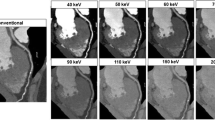Abstract
We evaluated Feldkamp artifacts, which are specific to cone-beam computed tomography (CT), in phantom and clinical studies using the 256-multidetector-row CT (256MDCT), and compared the reconstruction accuracy of axial and helical scans. Image noise, slice sensitivity profile (SSP) and artifacts with the 256MDCT were evaluated using a phantom, and the results were compared to those of a 64MDCT. We also examined chest and abdomen scans produced with the 256MDCT in volunteers. For the axial scan, Feldkamp artifacts were visualized as high-frequency streak-like artifacts that are oriented horizontally at the edge of the scan region in the phantom study. Similar results were obtained with the volunteers in soft-tissue regions near either bony structures or air pockets. Feldkamp artifacts with the 256MDCT can lead to misdiagnosis if not correctly identified and minimized via helical scanning. Image noise was less for axial than helical scans, while SSP was better with helical than axial scans. Feldkamp artifacts observed in the 256MDCT images, however, did not generally affect the interpretation of images. The 256MDCT promises more accurate diagnosis, and will provide volumetric cine images of wider cranio-caudal coverage, enabling new applications of CT.









Similar content being viewed by others
References
Endo M, Mori S, Tsunoo T, Kandatsu S, Tanada S, Aradate H, Saito Y, Miyazaki H, Satoh K, Matsushita S, Kusakabe M (2003) Development and performance evaluation of the first model of 4D CT-scanner. IEEE Trans Nucl Sci 50:1667–1671
Mori S, Endo M, Tsunoo T, Kandatsu S, Tanada S, Aradate H, Saito Y, Miyazaki H, Satoh K, Matsushita S, Kusakabe M (2004) Physical performance evaluation of a 256-slice CT-scanner for four-dimensional imaging. Med Phys 31(6):1348–1356
Mori S, Endo M, Obata T, Murase K, Fujiwara H, Susumu K, Tanada S (2005) Clinical potentials of the prototype 256-detector row CT-scanner. Acad Radiol 12(2):148–154
Mori S, Obata T, Kishimoto R, Kato H, Murase K, Fujiwara H, Kandatsu S, Tanada S, Tsujii H, Endo M (2005) Clinical potentials for dynamic contrast-enhanced hepatic volumetric cine imaging with the prototype 256-MDCT scanner. Am J Roentgenol 185(1):253–256
Kondo C, Mori S, Endo M, Kusakabe K, Suzuki N, Hattori A, Kusakabe M (2005) Real-time volumetric imaging of human heart without electrocardiographic gating by 256-detector row computed tomography: initial experience. J Comput Assist Tomogr 29(5):694–698
Mori S, Kondo C, Suzuki N, Yamashita H, Hattori A, Kusakabe M, Endo M (2005) Volumetric cine imaging for cardiovascular circulation using prototype 256-detector row computed tomography scanner (4-dimensional computed tomography): a preliminary study with a porcine model. J Comput Assist Tomogr 29(1):26–30
Mori S, Obata T, Nakajima N, Ichihara N, Endo M (2005) Volumetric perfusion CT using prototype 256-detector row CT scanner: preliminary study with healthy porcine model. Am J Neuroradiol 26(10):2536–2541
Mori S, Endo M, Tsunoo T, Kandatsu S, Tanada S, Funabashi N, Suzuki M (2004) Performance evaluation of the first model 4D CT. Proc 5th Japan-France Workshop Radiobiol Med Imaging 5:153–158
Suzuki M, Funabashi N, Mori S, Tanada S, Endo M, Moriya H (2004) Four-dimensional kinematics of the knee evaluated by high-speed cone beam computed tomography. Radiology SSC23 04:367
Mori S, Endo M, Kohno R, Minohara S, Kenya M, Fujiwara H (2005) Respiratory gated segment reconstruction algorithm for radiation treatment planning using 256-detector row CT-scanner during free breathing. Proc SPIE 5368:711–721
Feldkamp LA, Davis LC, Kress JW (1984) Practical cone-beam algorithm. J Opt Soc Am 1:612–619
Grangeat P (1991) Mathematical framework of cone-beam 3D reconstruction via the first derivative of the Radon transform. Mathematical methods in tomography, lecture notes in mathematics. Springer, Berlin Heidelberg New York
Kudo H, Saito T (2002) Three-dimensional helical-scan computed tomography using cone-beam projections. Syst Comput Jpn 23:75–82
Smith B (1985) Image reconstruction methods. IEEE Trans Medical Imaging 4:14–25
Tuy H (1983) An inversion fomula for cone-beam reconstruction. SIAM J Math 43:546–552
Saito Y, Aradate H, Igarashi K, Ide H (2001) Large area 2-dimensional detector for real-time 3-dimensional CT (4D CT). Proc SPIE 4320:775–782
Mori S, Endo M, Nishizawa K, Tsunoo T, Aoyama T, Fujiwara H, Murase K (2005) Enlarged longitudinal dose profiles in cone-beam CT and the need for modified dosimetry. Med Phys 32:1061–1069
Hein I, Taguchi K, Silver MD, Kazama M, Mori I (2003) Feldkamp-based cone-beam reconstruction for gantry-tilted helical multislice CT. Med Phys 30(12):3233–3242
Kachelriess M, Knaup M, Kalender WA (2004) Extended parallel backprojection for standard three-dimensional and phase-correlated four-dimensional axial and spiral cone-beam CT with arbitrary pitch, arbitrary cone-angle, and 100% dose usage. Med Phys 31(6):1623–1641
Flohr T, Stierstorfer K, Bruder H, Simon J, Polacin A, Schaller S (2003) Image reconstruction and image quality evaluation for a 16-slice CT scanner. Med Phys 30(5):832–845
Gies M, Kalender WA, Wolf H, Suess C (1999) Dose reduction in CT by anatomically adapted tube current modulation. I. Simulation studies. Med Phys 26(11):2235–2247
Kalender WA, Wolf H, Suess C (1999) Dose reduction in CT by anatomically adapted tube current modulation. II. Phantom measurements. Med Phys 26(11):2248–2253
Acknowledgements
We thank Mr. Naoki Sugihara and Mr. Hiroaki Miyazaki of Toshiba Medical Systems Corporation for supplying the reconstruction software.
Author information
Authors and Affiliations
Corresponding author
Rights and permissions
About this article
Cite this article
Mori, S., Endo, M., Obata, T. et al. Properties of the prototype 256-row (cone beam) CT scanner. Eur Radiol 16, 2100–2108 (2006). https://doi.org/10.1007/s00330-006-0213-6
Received:
Revised:
Accepted:
Published:
Issue Date:
DOI: https://doi.org/10.1007/s00330-006-0213-6




